Lumberjack
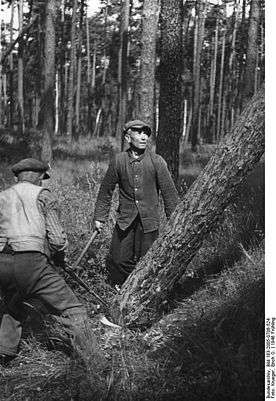
Lumberjacks are workers in the logging industry who perform the initial harvesting and transport of trees for ultimate processing into forest products. The term usually refers to a bygone era (before 1945 in the United States) when hand tools were used in harvesting trees. Because of its historical ties, the term lumberjack has become ingrained in popular culture through folklore, mass media and spectator sports. The actual work was difficult, dangerous, intermittent, low-paying, and primitive in living conditions. However, the men built a traditional culture that celebrated strength, masculinity, confrontation with danger, and resistance to modernization.[1]
Names
The term lumberjack is of Canadian derivation. The first attested use of the word comes from an 1831 letter to the Cobourg Star and General Advertiser in the following passage: "my misfortunes have been brought upon me chiefly by an incorrigible, though perhaps useful, race of mortals called LUMBERJACKS, whom, however, I would name the Cossack's of Upper Canada, who, having been reared among the oaks and pines of the wild forest, have never been subjected to the salutary restraint of laws."[2] The term lumberjack is primarily historical; logger is used by workers in the 21st century. When lumberjack is used, it usually refers to a logger from an earlier time before the advent of chainsaws, feller-bunchers and other modern logging equipment. Other terms for the occupation include woodcutter, and the colloquial term woodhick (Pennsylvania, US). A logger employed in driving logs down a river was known locally in northern North America as a river pig, catty-man, river hog, or river rat. The term lumberjill has been known for a woman who does this work; for example, in Britain during World War II.[3] In Australia, the occupation is referred to as timber cutter[4] or cool cutters.[5][6]
History
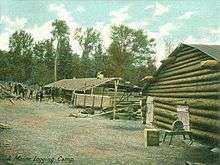
Lumberjacks worked in lumber camps and often lived a migratory life, following timber harvesting jobs as they opened.[7] Being a lumberjack was seasonal work. Lumberjacks were exclusively men. They usually lived in bunkhouses or tents. Common equipment included the axe and cross-cut saw. Lumberjacks could be found wherever there were vast forests to be harvested and a demand for wood, most likely in Scandinavia, Canada, and parts of the United States. In the U.S., many lumberjacks were of Scandinavian ancestry, continuing the family tradition. American lumberjacks were first centred in north-eastern states such as Maine. They then followed the general westward migration on the continent to the Upper Midwest, and finally the Pacific Northwest. Stewart Holbrook documented the emergence and westward migration of the classic American lumberjack in his first book, Holy Old Mackinaw: A Natural History of the American Lumberjack. He often wrote colourfully about lumberjacks in his subsequent books, romanticizing them as hard-drinking, hard-working men. Logging camps were slowly phased out between World War II and the early 1960s as crews could by then be transported to remote logging sites in motor vehicles.[8]
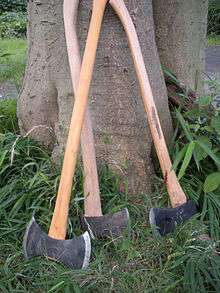
The division of labour in lumber camps led to several specialized jobs on logging crews, such as whistle punk, chaser, and high climber.[9] The whistle punk's job was to sound a whistle (usually at the Steam donkey) as a signal to the yarder operator controlling the movement of logs. He also had to act as a safety lookout. A good whistle punk had to be alert and think fast as the safety of the others depended on him. The high climber (also known as a tree topper) used iron climbing hooks and rope to ascend a tall tree in the landing area of the logging site, where he would chop off limbs as he climbed, chop off the top of the tree, and finally attach pulleys and rigging to the tree so it could be used as a spar so logs could be skidded into the landing. High climbers and whistle punks were both phased out in the 1960's to early 1970's when portable steel towers replaced spar trees and radio equipment replaced steam whistles for communication. The choker setters attached steel cables (or chokers) to downed logs so they could be dragged into the landing by the yarder. The chasers removed the chokers once the logs were at the landing. Choker setters and chasers were often entry-level positions on logging crews, with more experienced loggers seeking to move up to more skill-intensive positions such as yarder operator and high climber, or supervisory positions such as hook tender. Despite the common perception that all loggers cut trees, the actual felling and bucking of trees were also specialized job positions done by fallers and buckers. Faller and bucker were once two separate job titles but are now combined.[10]
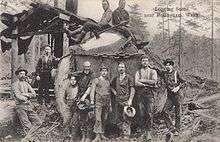
Before the era of modern diesel or gasoline powered equipment, the existing machinery was steam powered. Animal- or steam-powered skidders could be used to haul harvested logs to nearby rail roads for shipment to sawmills. Horse driven logging wheels was a means used for moving logs out of the woods. Another way for transporting logs to sawmills was to float them down a body of water or a specially-constructed log flume. Log rolling, the art of staying on top of a floating log while "rolling" the log by walking, was another skill much in demand among lumberjacks. Spiked boots known as "caulks" or "corks" were used for log rolling and often worn by lumberjacks as their regular footwear.
The term "skid row", which today means a poor city neighbourhood frequented by homeless people, originated in a way in which harvested logs were once transported. Logs could be "skidded" down hills or along a corduroy road, and one such street in Seattle was named Skid Road. This street later became frequented by people down on their luck, and both the name and its meaning morphed into the modern term.
The tie hack
A specialty form of logging involving the felling of trees for the production of railroad ties was known as tie hacking. These lumberjacks, called tie hacks, used saws to fell trees and cut to length, and a broadaxe to flatten two or all four sides of the log to create railroad ties. Later, portable saw mills were used to cut and shape ties. Tie hacking was an important form of logging in Wyoming and northern Colorado and the remains of tie hacking camps can be found on National Forest land. The remains of flumes can be seen near Dubois, Wyoming[11] and Old Roach, Colorado. In addition, a decaying splash dam exists near the Old Roach site as well. There tie hacks attempted to float logs down to the Laramie River for the annual spring tie drives, and the splash dam was used to collect winter snowmelt to increase the water flow for the tie drive.[12]
Lumberjack culture
Tomczik (2008) has investigated the lifestyle of lumberjacks in 1840-1940, using records from mostly Maine and Minnesota logging camps. In a period of industrial development and modernization in urban areas, logging remained a traditional business in which the workers exhibited pride in their craft, their physical strength and masculinity, and guarded their individualism. Their camps were a bastion of the traditional workplace as they defied modern rationalized management, and built a culture around masculinity. At the peak in 1906 there were 500,000 lumberjacks; they took special pride in their work. Logging camps were located in isolated areas that provided room and board as well as a workplace. With few females present other than the wives of cooks and foremen, lumberjacks lived an independent life style that emphasized manly virtues in doing dangerous tasks. Men earned praise for their skills in doing their work, for being competitive, and for being aggressive. When not at work, they played rough games, told tall tales, and won reputations for consuming large amounts of food. By 1940, the business was undergoing major changes, as access roads and automobiles ended residential logging camps, chain saws replaced crosscut saws, and managers installed modern industrial methods.[13]
Modern logger
Modern technology changed the job of the modern logger considerably. Although the basic task of harvesting trees is still the same, the machinery and tasks are no longer the same. Many of the old job specialities on logging crews are now obsolete.
Chainsaws, harvesters, and feller bunchers are now used to cut or fell trees. The tree is turned into logs by removing the limbs (delimbing) and cutting it into logs of optimal length (bucking). The felled tree or logs are moved from the stump to the landing. Ground vehicles such as a skidder or forwarder can pull, carry, or shovel the logs. Cable systems "cars" can pull logs to the landing. Logs can also be flown to the landing by helicopter. Logs are commonly transported to the sawmill using trucks. Harvesting methods may include clear cutting or selective cutting. Concerns over the environmental impact have led to controversy about modern logging practices. In certain areas of forest loggers re-plant their crop for future generations.
A recent Wall Street Journal survey on the best jobs in the United States ended by listing being a logger as the "worst" 3D's job,[14] citing "work instability, poor income and pure danger". A Bureau of Labor Statistics survey of America's most dangerous jobs put loggers at the top of the list for 2004.
Loggersports
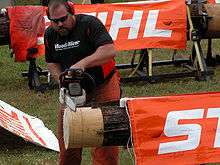
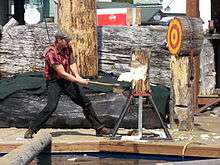
The modern lumberjack can be found in our competitive culture, because of the competitions in the old lumber camps to see who the best lumberjack was. Today these competitions are used to acknowledge the rich history of forestry and logging and to keep traditions alive. This is reflected in the events at these competitions.
The STIHL Timbersports Series was founded in 1985 and brings competitors from across the world to compete in six disciplines showcasing the skills of lumberjacks. The events are broadcast worldwide on a variety of networks, including ESPN, ABC, Eurosport and more.[15]
The Lumberjack World Championship, held in Hayward, Wisconsin. The competition began in 1960 and is now one of the largest spectator gatherings of the sport, bringing in over 12,000 viewers on an annual basis.
In Canada, Squamish Days Loggers Sports in Squamish, British Columbia, attracts world class competitors to its weekend festival in August every year. The event attracted the likes of Johnny Cash, who, in 1991, performed at the 5,000-seat Loggers Sports grounds during his Roadshow tour, and stuck around to take part in the events and accept a chainsaw carving of his initials.[16]
The Woodsmen's Days events at Tupper Lake, New York commemorate the lumberjack with logging competitions and demonstrations during mid-July.
Many colleges have woodsmen teams or forestry clubs, which compete regionally, nationally, and internationally. The Association of Southern Forestry Clubs, for example, sponsors an annual Forestry Conclave with 250 contestants in various events.
There are also lumberjack shows which tour the United States, demonstrating old lumber practices to the general public. The Lumberjack World Championships have been held annually in Hayward, Wisconsin, since 1960.[17] Over twelve thousand visitors come to this small northern Wisconsin town each year in late July to watch men and women compete in 21 different events, including log rolling, chopping, timed hot (power) saw and bucksaw cutting, and pole climbing.
Popular culture
In popular culture, the stereotypical lumberjack is a strong, burly, usually bearded man who lives to brave the natural environment. He is depicted wearing suspenders, a long-sleeved plaid flannel shirt, and heavy caulk boots, and is often characterized as having an enormous appetite for flapjacks. He works by cutting down trees with either an axe or with the help of another lumberjack and a crosscut saw, as opposed to the modern chainsaw.[18]
Folklore
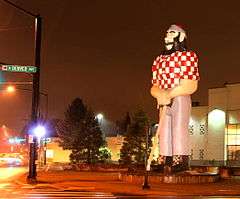
The most famous depiction of a lumberjack in folklore is Paul Bunyan. Several towns claim to have been Paul Bunyan's home and have statues of Bunyan and his ox "Babe" in the town.[19]
Perhaps one of the most famous "authentic" folk heroes of the lumber trade was Joseph Montferrand, better known as Big Joe Mufferaw, a French-Canadian logger known for his physical prowess and desire to protect the French Canadian logger.[20]
Festivals and holidays
- Lumberjack Day, also called National Pancake Day since 2013,[21] is a celebration that dates back to the mid-2000s, when Marianne Ways and Colleen AF Venable (a former lumberjack) decided to honor the lumberjack profession and provide an excuse to go out and eat pancakes and waffles with friends, dress up in the cliché lumberjack style of plaid shirts, boots, suspenders, and beards, and pursue other activities posted on the official Lumberjack Day website.[22]
Food and eateries
In Canada and the U.S., various desserts, dishes, meals, and eateries bear the name lumberjack or lumberjacks, such as:
- Desserts
- Dishes
- lumberjack bean bake,[25][26]
- lumberjack beans,[27]
- lumberjack breakfast casserole,[28]
- lumberjack casserole,[29]
- lumberjack chili,[30]
- lumberjack omelet,[31]
- lumberjack pancakes,[32][33]
- lumberjack sandwiches,[34]
- lumberjack sausage,[35][36]
- lumberjack soup,[37]
- lumberjack stew,[38][39][40][41]
- Beer
- Lumberjack Morning Break - Imperial Maple Coffee Stout aged in bourbon barrels by 3 Sons Brewing Co
- Meals
In Canada and the USA, a lumberjack breakfast is a hearty full breakfast.[42]
- Eateries
- Lumberjack Steakhouse and Lodge, in Hayward, Wisconsin, is located at the venue which hosts lumberjack competitions.[43]
Art, entertainment, and media
Films
- Lumberjack (film) is a 1944 American film directed by Lesley Selander
- Ferngully: The Last Rainforest is a 1992 American animated film directed by Bill Kroyer
Literature and film adaptations
- William Durbin's book Blackwater Ben (2003) is about a boy who gets to live with his father as a cook in a lumberjack camp.
- Ken Kesey's novel Sometimes a Great Notion (1964), adapted for the film Sometimes a Great Notion (1971 movie), is about a family of lumberjacks in Oregon.
- Canadian artist William Kurelek wrote and illustrated a book called Lumberjack (1974), about his days working in a logging camp.[44]
- Maddox's book The Alphabet of Manliness (2006) lists the lumberjack as one of 26 examples of the pinnacle of manliness; Maddox goes on make such factual claims such as: lumberjacks are raised by Cyclops
Music
Lumberjacks rapidly developed their own distinctive musical culture of work songs. Many were based on traditional European folk tunes, with lyrics that reflected the lives, experiences and concerns of lumberjacks, with the themes of cutting, hauling, rolling, and driving, as well as narrative songs that involved romance.[45]
Groups
- Lumberjack Band, a marching band who played at Green Bay Packers games
- Lumberjacks (group), the hip hop duo between rappers T-Mo and Khujo
Songs
- Big Joe Mufferaw, a song recorded and performed by Stompin' Tom Connors, one of Canada's most prolific and well-known country and folk singer-songwriters, about legendary folk hero Joseph Montferrand, a French-Canadian logger. This song appears on the album Stompin' Tom Meets Big Joe Mufferaw (1970), on the live album Live At The Horseshoe (1971), and on the album Move Along With Stompin' Tom (1999).
- "Chainsaw" is a song by Family Force 5
- "Lumberjack" (1960), a song by Johnny Cash on his album Ride This Train (1960)
- "The Lumberjack" (song), a song by Hal Willis
- "The Lumberjack", a song featuring a chainsaw solo, by the American rock band Jackyl
- "The Lumberjack Song", a song by Monty Python, known for its refrain: "I'm a lumberjack and I'm okay / I sleep all night and I work all day"
Periodicals
- The Lumberjack (Humboldt State University) is a Humboldt State University newspaper
- The Lumberjack (Northern Arizona University) is a Northern Arizona University newspaper
Television
The lives of loggers have been featured on the following American television series:
- American Loggers on the Discovery Channel
- Ax Men on History
- Here Come the Brides
- The Pink Panther cartoon short, Pink Campaign
- Wacky Races
- Gravity Falls
Sports
Mascots and teams
The lumberjack is the mascot and athletics team name at multiple schools, including:
- Dakota College at Bottineau, North Dakota, originally founded as the School of Forestry
- Humboldt State University, located at the outskirts of a coast redwood forest in Humboldt County, California, where the mascot is alternately referred to as The Lumberjack and the Lucky Logger
- Northern Arizona University, located in Flagstaff, Arizona
- Stephen F. Austin State University in Nacogdoches, Texas, where the mascot pays homage to the timber industry of the East Texas region in which the university is located
- Tupper Lake High School in Tupper Lake, New York, where the mascot pays homage to the timber industry of the Adirondack region in which the school is located
Lumberjack or lumberjacks is also the name of numerous non-academic sports teams:
- Adirondack Lumberjacks, an independent professional baseball team based in Glens Falls, New York
- Bangor Lumberjacks, an independent baseball team based in Bangor, Maine
- Cleveland Lumberjacks, an ice hockey team based in Cleveland, Ohio
- Granite City Lumberjacks, a junior ice hockey team based in Sauk Rapids, Minnesota
- Muskegon Lumberjacks (1984–1992), a defunct International Hockey League team based in Muskegon, Michigan
- Muskegon Lumberjacks (1992–2010), a defunct International Hockey League team based in Muskegon, Michigan
- Muskegon Lumberjacks, a Tier 1 junior ice hockey team in the Eastern Conference of the United States Hockey League
- Portland LumberJax, a defunct National Lacrosse League team based in Portland, Oregon
Competitions and events
- The Lumberjack 100, an ultra-endurance mountain bike race held the 3rd Saturday in June at Michigan's Big M Cross Country Ski and Mountain Bike Trail in the Manistee National Forest
- A lumberjack competition is regular event at the annual Geauga County Maple Festival, held every April in Chardon, Ohio
- In a lumberjack match, the ring is surrounded by a group of wrestlers who are not directly involved in the match but are there to prevent the opponents in the match from fleeing the ring. Lumberjill matches involve female wrestlers.
- Lumberjack sports, generic type of sports including traditional logging, wood chopping, and related woodsman individual and team competitions
- Lumberjack World Championship, described above
- STIHL Timbersports Series, described above
Train
- The Lumberjack Steam Train is a passenger excursion train operated by the Laona and Northern Railway
See also
References
Notes
- ↑ Hayner, 1945
- ↑ "Occupational Image: Lumberjacks". Tyler Rudd Putman. 2012-06-05. Retrieved 2013-05-12.
- ↑ "WW2 People's War - The Lumberjills of Scotland". BBC. 2005-08-03. Retrieved 2010-09-12.
- ↑ "Govt works towards timber cutter compo". ABC News (Australian Broadcasting Corporation). 2005-05-17. Retrieved 2010-09-12.
- ↑ "Our house: histories of Australian homes - Koongalba, The timber getter's residence". Environment.gov.au. 2008-08-07. Retrieved 2010-09-12.
- ↑ Archived July 19, 2008, at the Wayback Machine.
- ↑ Rohe, 1986
- ↑ Smith (1972)
- ↑ Radford (1987)
- ↑ Sorden and Vallier, 1986
- ↑ Pinkerton, Joan (1981). Knights of the Broadax; the Story of the Wyoming Tie Hack. ISBN 0-87004-283-1.
- ↑ Jones, Keith. History of Jelm, Wyoming, Vol. 1. p. 17.
- ↑ Adam Tomczik, "'He-men Could Talk to He-men in He-man Language'": Lumberjack Work Culture in Maine and Minnesota, 1840–1940," Historian Winter 2008, Vol. 70 Issue 4, pp 697-715
- ↑ "Career & Job News, Work, Employment & Salary Trends - Wall Street Journal - WSJ.com". Careerjournal.com. Retrieved 2010-09-12.
- ↑ "STIHL TIMBERSPORTS | Lumberjack Competition Series". www.stihlusa.com. Retrieved 2016-07-08.
- ↑ Sylvie Paillard spaillard@squamishchief.com (2010-07-25). "The spectacle on the world stage". Squamishchief.com. Retrieved 2015-10-15.
- ↑ Murphy McGinnis Interactive. "Hayward, Wisconsin". Lumberjack World Championships. Retrieved 2010-09-12.
- ↑ Samuel, R. & Thompson, P. R. (1990). The Myths We Live By. London: Taylor & Francis. pp. 132–6.
- ↑ Dorson, R.M. (1961). American folklore: with revised bibliographical notes (2nd (1977) ed.). University of Chicago Press. p. 216.
- ↑ Colombo, J.R. (1984). Canadian literary landmarks. Dundurn Press. p. 158.
- ↑ "ABOUT LUMBERJACK DAY! (also dubbed National Pancake Day) Celebrated every September 26!". lumberjackday.net.
- ↑ "Lumberjack Day". daysoftheyear.com. Retrieved January 1, 2016.
- ↑ "Lumberjacks - Molasses Cookies". Cooks.com. Retrieved January 1, 2016.
- ↑ "Lumberjacks". Cooks.com. Retrieved January 1, 2016.
- ↑ "Lumberjack Bean Bake". Cooks.com. Retrieved January 1, 2016.
- ↑ "Lumberjack Bean Bake". Cooks.com. Retrieved January 1, 2016.
- ↑ "Lumberjack Beans". Cooks.com. Retrieved January 1, 2016.
- ↑ "Lumberjack Breakfast Casserole". Cooks.com. Retrieved January 1, 2016.
- ↑ "Lumberjack Casserole". Cooks.com. Retrieved January 1, 2016.
- ↑ "Lumberjack Chili". Cooks.com. Retrieved January 1, 2016.
- ↑ "Lumberjack Omelet". Cooks.com. Retrieved January 1, 2016.
- ↑ "Lumberjack Pancakes Recipe". cooksrecipes.com. Retrieved January 1, 2016.
- ↑ "Lumberjack Pancakes Recipe". recipetips.com. Retrieved January 1, 2016.
- ↑ "Safeway Lumberjack Sandwich Recipe". caloriecount.com. Retrieved January 1, 2016.
- ↑ "Lumberjack Smoked Sausage Carton". RogerWoodFoods.com. Retrieved January 1, 2016.
- ↑ "Lumberjack Sausage Stew Recipes". Spark Receipe. Retrieved January 1, 2016.
- ↑ "Lumberjack Soup". Cooks.com. Retrieved January 1, 2016.
- ↑ "Lumberjack Stew (Crock Pot)". Food.com. Retrieved January 1, 2016.
- ↑ Cooks.com http://www.cooks.com/recipe/hh9120j4/lumberjack-omelet.html. Retrieved January 1, 2016. Missing or empty
|title=(help) - ↑ "Lumberjack Stew". Cooks.com. Retrieved January 1, 2016.
- ↑ "Lumberjack Stew". Cooks.com. Retrieved January 1, 2016.
- ↑ "Big Breakfasts, Dinner Dates, Fish & the Dishes Read more: Lumberjack Breakfast – Origin of the Term Lumberjack Breakfast". Esquire. Retrieved 8 October 2013.
- ↑ "Lumberjack Steakhouse and Lodge". zomato.com.
- ↑ Kurelek, William (1974). Lumberjack. ISBN 0-88776-378-2.
- ↑ Mood, T. A. (2004). American Regional Folklore: A Sourcebook and Research Guide. ABC-CLIO. pp. 220–2.
Bibliography
- Brock, Emily K. Money Trees: The Douglas Fir and American Forestry, 1900-1944 (Oregon State University Press, 2015). 272 pp.
- Chaney, Michael P. White Pine on the Saco River: An Oral History of River Driving in Southern Maine (University of Maine Press, 1993)
- Cox, Thomas R. The Lumberman's Frontier: Three Centuries of Land Use, Society, and Change in America's Forests (Oregon State University Press, 2010); 560 pages; examines successive frontier regions prized for lumber rather than farming, beginning with northern New England in the 17th century
- Griffiths, Bus. Now You're Logging, Harbour Publishing, 1978.
- Hayner, Norman S. "Taming the Lumberjack," American Sociological Review, Vol. 10, No. 2, (April, 1945), pp. 217–225 in JSTOR, description of life style
- Holbrook, Stewart H. Holy Old Mackinaw: A Natural History of the American Lumberjack, 1938, popular
- Holbrook, Stewart H. The American Lumberjack (Collier Books, 1962), popular account
- Karamanski, Theodore J. Deep Woods Frontier: A History of Logging in Northern Michigan (1989)
- Lee, David. Lumber Kings and Shantymen. Ottawa, Canada: 2006.
- Lemonds, James. Deadfall: Generations of Logging in the Pacific Northwest. Missoula: Mountain Press, 2001.
- Mackay, Donald. "The Canadian Logging Frontier," Journal of Forest History 1979 23(1): 4-17
- Radforth, Ian. Bushworkers and Bosses: Logging in Northern Ontario, 1900–1980 (University of Toronto Press, 1987).
- Robbins, William G. Lumberjacks and Legislators: Political Economy of the U.S. Lumber Industry, 1890-1941 (Texas A. & M. U. Press, 1982). 268 pp.
- Roberge, Earl. Timber Country. Caldwell, Idaho: Caxton Printers, 1973.
- Rohe, Randall E. "The Evolution of the Great Lakes Logging Camp, 1830-1930," Journal of Forest History 1986 30(1): 17-28
- Smith, David C. A History of Lumbering in Maine, 1861–1960 (University of Maine Press, 1972)
- Sorden, L. G. and Vallier, Jacque. Lumberjack Lingo: A Dictionary of the Logging Era. (Ashland, Wis.: NorthWord, 1986). 288 pp.
- Tomczik, Adam, "'He-men Could Talk to He-men in He-man Language'": Lumberjack Work Culture in Maine and Minnesota, 1840–1940," Historian Winter 2008, Vol. 70 Issue 4, pp 697–715
External links
| Look up lumberjack in Wiktionary, the free dictionary. |
| Wikimedia Commons has media related to Lumberjacks. |
- William Reed (Timber getter) c.1930 - photo from the Jones-Mashman Collection at Lake Macquarie Library.
- University of Washington Libraries: Digital Collections:
- Clark Kinsey Photographs Over 1000 images by commercial photographer Clark and his brother Darius Kinsey documenting the logging and milling camps and other forest related activities in Washington State, ca. 1910-1945.
- Industry and Occupations Photographs An ongoing and expanding collection devoted to the workers in the Pacific Northwest from 1880s-1940s. Many occupations and industries are represented including the logging and lumber industry.
- Man to Machine: Peninsula Logging Online museum exhibit based upon the Clark Kinsey Logging Photographs Collection and the recollections of Harry C. Hall, who worked as a logger on the Olympic Peninsula in the early 20th century. Includes a video on the Hobi family logging history (late 19th century – early 20th century).